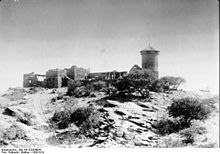Schwerinsburg (Windhoek)
| Schwerinsburg | ||
|---|---|---|
|
Schwerinsburg |
||
| Creation time : | 1890-1913 | |
| Castle type : | Summit castle | |
| Conservation status: | receive | |
| Geographical location | 22 ° 34 '24 " S , 17 ° 5' 33" E | |
| Height: | 1659 m above sea level NHN | |
|
|
||
The Schwerinsburg is the largest of the three castles of Windhoek and is located on a ridge in the Windhoek luxury hill district .
Its history begins in 1890, when Curt von François had a signal tower built on its current site for safety reasons to connect Windhoek and Klein-Windhoek . The signal tower consisted only of bricked mud bricks with a thatched roof and stone entrenchments with loopholes, so it was not surprising that it fell into disrepair in 1894 after the end of the Witbooi Wars.
A short time later, Rudolf Moeller opened a beer tavern and restaurant in the ruins.
In the 1890s he had his restaurant converted into a "castle ruin" by the German architect Wilhelm Sander . The old stone walls were plastered with clay and thus integrated into the ruin. In addition, a high round crenellated tower was built. Round arches were used inside the restaurant and the walls were painted with murals and humorous sayings by the Windhoek painter Erich Mayer. The castle ruin restaurant was christened "Sperlingslust".
But that shouldn't stay that way for long either. In 1904/1905, during the Herero uprising , the tower of the "Sperlingslust" restaurant was again used as a guard for a short time. But due to lack of use, it was sold again to a private person who in turn opened a restaurant there. This did not flourish for long, and so the entire property finally came into the possession of Hans Bogislav Graf von Schwerin in 1913 . In the same year, impressed by the view over the wide valley, he commissioned the then star architect Wilhelm Sander, the builder of “Sperlingslust”, to convert it into a romantic castle.
A special feature of the castle is a 104 m deep borehole in the castle courtyard, which the count had drilled into the ground in order to encounter water there. In memory of the Schwerinsburg family castle in Western Pomerania , built in 1721, where he grew up, he also named the castle that way. Not far from the “Schwerinsburg”, architect Sander erected another castle-like building for himself on a slightly lower hill in 1914. But two years later (1916) he also sold this to Count Schwerin, who then named the system after his wife's family Heinitzburg .
Schwerinsburg is currently privately owned, but was the residence of the Italian ambassador in Namibia until the beginning of 2013 .


